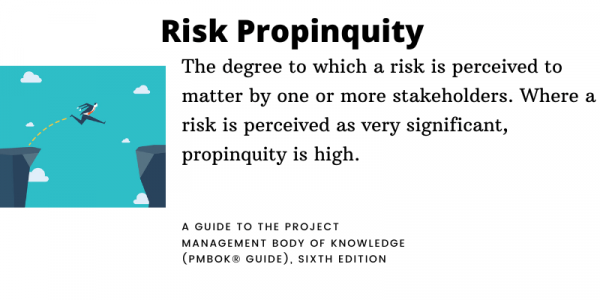According to the PMBOK, the degree to which a risk is perceived to matter by one or more stakeholders is called risk propinquity. This evaluates the degree of closeness or proximity between a project manager and a project’s risks. In other words, it’s a measure of how likely a project manager is to encounter or be affected by a project’s risks.
A risk’s propinquity is a function of its potential severity and the likelihood that it will materialize. The concept of propinquity is important because it helps stakeholders prioritize risks.
Risk propinquity is often used in conjunction with other risk management concepts, such as the project manager’s authority to make decisions about how to deal with risks. When multiple stakeholders are involved in a project, the degree of propinquity may vary among them.
Risk levels in project management
When identifying risks for a project, it is important to consider both the likelihood of the risk occurring and the potential impact of the risk. Risks with a high likelihood of occurring but a low impact can be managed with minimal effort, while risks with a low likelihood of occurring but a high impact should be given more attention.
Once the risks have been identified and assessed, they can then be managed accordingly. There are a variety of ways to manage risks, and the most appropriate approach will depend on the specific risks involved.

Methods used to rate potential risk
In any project, there is always the potential for risks. By understanding and rating these potential risks, project managers can be better prepared to handle them should they occur.
There are a few different ways to rate potential risks. One method is to rate them by their likelihood of occurring, with 1 being the lowest likelihood and 5 being the highest. Another method is to rate them by their potential impact, with 1 being the lowest impact and 5 being the highest.
Once you have rated the potential risks, you can then prioritize them and develop plans to mitigate them.
In order to successfully manage a project, it is essential to be able to identify and assess risks. There are a variety of methods that can be used to do this, and each has its own strengths and weaknesses.
One of the most common methods is the use of a risk matrix, which is a tool used to assess the likelihood and potential impact of a given risk. Other methods include the use of probabilities, scenarios, and user stories.
Some other methods used to assess risks include the Delphi Technique, the Precedence Diagramming Method, and the SWOT Analysis.
Each of these methods has its own advantages and disadvantages, so it is important to choose the one that is best suited to the particular project you are working on.
For example, the Delphi Technique is often used when there is a need to reach a consensus among experts, while the Precedence Diagramming Method is more suited to projects with a large number of activities and a high degree of interdependence.
How can risk propinquity impact your project management?
Risk propinquity can impact your project management in a few different ways.
- It can impact the decision-making process. If people are more likely to take risks, they may be more likely to make decisions without fully considering the consequences. This can lead to poor decision-making and can ultimately put the project at risk.
- Risk propinquity can impact the number of resources that are dedicated to the project. If people are more willing to take risks, they may be more willing to invest more resources into the project. This can lead to over-investment and can ultimately put the project at risk.
- Risk propinquity can impact the timeline of the project. If people are more willing to take risks, they may be more likely to try and accomplish tasks in a shorter time frame. This can lead to unrealistic expectations and can ultimately put the project at risk.
FAQs
What is Risk Propinquity in Project Management?
In project management, propinquity is used to assess and manage risk. By understanding how risks are perceived by stakeholders, project managers can identify potential problems early and take steps to avoid them.
What are some common methods to rate potential risk?
A risk matrix, which is a tool used to estimate the possibility and possible impact of a specific risk, is one of the most prevalent ways. Other approaches include using probability, scenarios, and user stories.Other risk assessment techniques include the Delphi Technique, the Precedence Diagramming Method, and the SWOT Analysis.
How can Risk propinquity negatively impact your project?
For starters, it can influence decision-making. People who are more willing to take risks may make judgments without fully understanding the repercussions. This can lead to poor decision-making and, eventually, jeopardize the project.
